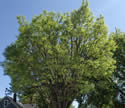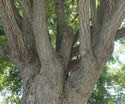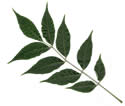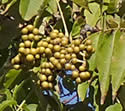Phellodendron amurense (Amur Corktree)
| Also known as: | |
|---|---|
| Genus: | Phellodendron |
| Family: | Rutaceae (Rue) |
| Life cycle: | perennial woody |
| Origin: | Asia |
| Status: |
|
| Habitat: | part shade, shade, sun; average to moist soil; woodlands, roadsides, waste places, parks, old fields |
| Bloom season: | May - June |
| Plant height: | 30 to 50 feet |
| Wetland Indicator Status: | none |
| MN county distribution (click map to enlarge): |  |
| National distribution (click map to enlarge): |  |
Pick an image for a larger view. See the glossary for icon descriptions.
Detailed Information
Flower: 

![[photo of male flowers]](/udata/r9ndp23q/trees/phellodendron-amurense-amur-corktree_0603_095429-t.jpg) Branching clusters of several to numerous flowers arising from leaf axils, with male and female flowers on separate plants (dioecious). Flowers are yellowish-green, sometimes reddish, about 1/8 inch across, lack petals but have 5 sepals. Male flowers have 5 yellowish stamens. Female flowers have a style with a greenish to dark red disc-shaped stigma sitting atop a round green ovary. Flower stalks are hairless or hairy.
Branching clusters of several to numerous flowers arising from leaf axils, with male and female flowers on separate plants (dioecious). Flowers are yellowish-green, sometimes reddish, about 1/8 inch across, lack petals but have 5 sepals. Male flowers have 5 yellowish stamens. Female flowers have a style with a greenish to dark red disc-shaped stigma sitting atop a round green ovary. Flower stalks are hairless or hairy.
Leaves and stems: 

![[photo of compound leaf]](/udata/r9ndp23q/trees/phellodendron-amurense-amur-corktree_0603_095457-t.jpg) Leaves are opposite, compound, 10 to 15 inches (25 to 38 cm) long with 5 to 11 leaflets that are often droopy. Leaflets are 2 to 4½ inches (6 to 11.5 cm) long and up to 2 3/8 inches (3 to 6 cm) wide, narrowly egg-shaped to lance-elliptic, rounded to tapering at the base, long or short tapering to a pointed tip, and on a short, hairy stalk. Edges are toothless; the upper surface is dark green and a bit shiny, the lower surface pale green, hairless or hairy along the veins.
Leaves are opposite, compound, 10 to 15 inches (25 to 38 cm) long with 5 to 11 leaflets that are often droopy. Leaflets are 2 to 4½ inches (6 to 11.5 cm) long and up to 2 3/8 inches (3 to 6 cm) wide, narrowly egg-shaped to lance-elliptic, rounded to tapering at the base, long or short tapering to a pointed tip, and on a short, hairy stalk. Edges are toothless; the upper surface is dark green and a bit shiny, the lower surface pale green, hairless or hairy along the veins.
![[photo of twig, buds and leaf scar]](/udata/r9ndp23q/trees/phellodendron-amurense-amur-corktree_1104_115910-t.jpg) New twigs are hairy or smooth, green turning reddish to brown, somewhat shiny with prominent white lenticels (pores). Leaf scars are relatively large, U-shaped, almost entirely surrounding the bud.
New twigs are hairy or smooth, green turning reddish to brown, somewhat shiny with prominent white lenticels (pores). Leaf scars are relatively large, U-shaped, almost entirely surrounding the bud.
![[photo of corky bark]](/udata/r9ndp23q/trees/phellodendron-amurense-amur-corktree_0520_161104-t.jpg) Bark becomes deeply furrowed with corky ridges, the outer bark gray to gray-brown, the inner bark bright yellow. Trunks can reach 3 feet diameter at breast height (dbh).
Bark becomes deeply furrowed with corky ridges, the outer bark gray to gray-brown, the inner bark bright yellow. Trunks can reach 3 feet diameter at breast height (dbh).
Fruit: 
![[photo of fruit]](/udata/r9ndp23q/trees/phellodendron-amurense-amur-corktree_1104_114155-t.jpg) Fruit is a round, berry-like drupe, about 3/8 inch (1 cm) diameter, ripening from green to black or purplish-black in late summer or early fall. Inside is a hard stone containing 5 seeds. Fruit can persist through winter.
Fruit is a round, berry-like drupe, about 3/8 inch (1 cm) diameter, ripening from green to black or purplish-black in late summer or early fall. Inside is a hard stone containing 5 seeds. Fruit can persist through winter.
Notes:
Amur Corktree is a fairly distinct species, but the compound leaves are similar to a number of natives, including Ash (Fraxinus spp.) and other trees with compound leaves. Amur Corktree is distinguished by the combination of: opposite leaves, toothless leaflets that are short-stalked, panicles of small greenish 5-parted flowers, and black berry-like fruit. When crushed, the foliage and fruit have a distinct odor that's been described as either citrus-y or like turpentine, and scraping off the outer bark reveals a bright yellow inner bark, most easily seen on branches and small stems. Leaf scars on twigs are also pretty unique, U-shaped and nearly surrounding the associated bud.
In researching this species, most references noted the crown is typically as wide as or wider than tall, but the trees in the St. Paul neighborhood where most of these images were taken did not all show that; several had crowns that were much taller than wide, but pruning may have affected that. The branching on most struck me as much like a Medusa head, with numerous thick branches coming off the stout trunk at about the same point.
Amur Corktree is native to eastern Asia and was introduced to North America in the 1850s. It tolerates a wide range of growing conditions, including heavy shade, and was most often planted in urban areas including parks, golf courses, residential boulevards and highway medians. However, like numerous other introductions, it escaped cultivation, usually via birds that eat the fruit, and invaded natural areas. When fruit drops under the mother tree thousands of seedlings can emerge, shading out other vegetation. To pour salt in the wound, it is also allelopathic, releasing chemicals in the soil that negatively impact microorganisms and other plants.
Its sale is now prohibited in some states. In 2023 the Minnesota Dept of Agriculture added it to the “specially regulated” list, so only male cultivars may be sold here—females are banned, as are any cultivars that may have perfect flowers. This lets the nursery trade continue making money selling bad plants! This special designation also requires that “all existing planted and and escaped fruit producing trees must be controlled, by tree removal or other means, such that no seed is disseminated”, but how that is accomplished or enforced? There is a report of a 1-acre infestation in southeastern Houston County. In St. Paul there are whole neighborhoods where this was planted in boulevards decades ago. One wonders how long it will be before any of the fruit-bearing trees are removed from there, as well as who will pay for it.
If you have this tree on your property, the MN DNR has some info on control methods that may be helpful.
Native Plant Nurseries, Restoration and Landscaping Services ↓
More photos
 Amur Corktree in a residential boulevard
Amur Corktree in a residential boulevard a Medusa head of branches
a Medusa head of branches leaf scan
leaf scan branches with immature fruit
branches with immature fruit inner bark is bright yellow
inner bark is bright yellow
Photos by K. Chayka taken in Ramsey County. Photo by Michael Lynch taken in Hennepin County.
Comments
Have you seen this plant in Minnesota, or have any other comments about it?






